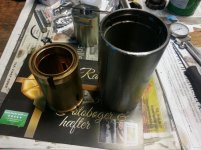Brian_Petersen
Plastic
- Joined
- Apr 20, 2017
Hi,
My name is Brian and I come from Denmark and have just registered. I have read a lot of different posts regarding the issue I have, but it's not quite the same problem.
I have just bought an older MAHO MH 600 manual milling machine (from the 60's I guess). The price was really good, so I drove for 15 min. and made a quick inspection and bought it after been having a good conversation with the previous owner. I asked for the spindle runout and he mentioned that he had just replaced the bearings and he also showed me some nice looking gears he had just made, so all seemed good.
After a few days when I got on to do some serious inspection, I was disappointed to see that the runout was around 0.07 mm or 0.0028 in! The manual says 0.005 mm or 0.0002 in is acceptable.
I then disassembled the whole spindle and found that it had a tapered bronze plain bearing in the lower part and two thrust bearings in the upper part of the housing. The two thrust bearings are located on both sides of a positive stop and thereby constraining the journal axially.
With this knowledge, I guessed that the taper was i bit worn and shimmed the lower thrust bearing, so that the tapered journal would register better into the tapered bronze bearing. I ended up shimming it 0.09 mm or 0.0035 in.
I got the runout down to about 0.04 mm or 0.0016 in, but the journal then began to drag on one or two spots.
My fear is that the lubrication of the bronze bearing was neglected and it all got very warm, maybe bending the journal. I don't know if this is a right assumption, but it seems plausible.
I have tried to place the journal in two V-blocks, but the tapered end gets me into trouble making runout measurements.
Please help me with some guidance on how to take the necessary steps and in the best order, to deal with this problem.
PS: Is it correct that the runout will be better doing a actual job, because the journal somewhat self-aligns on the oil film?
Regards,
Brian.




My name is Brian and I come from Denmark and have just registered. I have read a lot of different posts regarding the issue I have, but it's not quite the same problem.
I have just bought an older MAHO MH 600 manual milling machine (from the 60's I guess). The price was really good, so I drove for 15 min. and made a quick inspection and bought it after been having a good conversation with the previous owner. I asked for the spindle runout and he mentioned that he had just replaced the bearings and he also showed me some nice looking gears he had just made, so all seemed good.
After a few days when I got on to do some serious inspection, I was disappointed to see that the runout was around 0.07 mm or 0.0028 in! The manual says 0.005 mm or 0.0002 in is acceptable.
I then disassembled the whole spindle and found that it had a tapered bronze plain bearing in the lower part and two thrust bearings in the upper part of the housing. The two thrust bearings are located on both sides of a positive stop and thereby constraining the journal axially.
With this knowledge, I guessed that the taper was i bit worn and shimmed the lower thrust bearing, so that the tapered journal would register better into the tapered bronze bearing. I ended up shimming it 0.09 mm or 0.0035 in.
I got the runout down to about 0.04 mm or 0.0016 in, but the journal then began to drag on one or two spots.
My fear is that the lubrication of the bronze bearing was neglected and it all got very warm, maybe bending the journal. I don't know if this is a right assumption, but it seems plausible.
I have tried to place the journal in two V-blocks, but the tapered end gets me into trouble making runout measurements.
Please help me with some guidance on how to take the necessary steps and in the best order, to deal with this problem.
PS: Is it correct that the runout will be better doing a actual job, because the journal somewhat self-aligns on the oil film?
Regards,
Brian.




Last edited:







